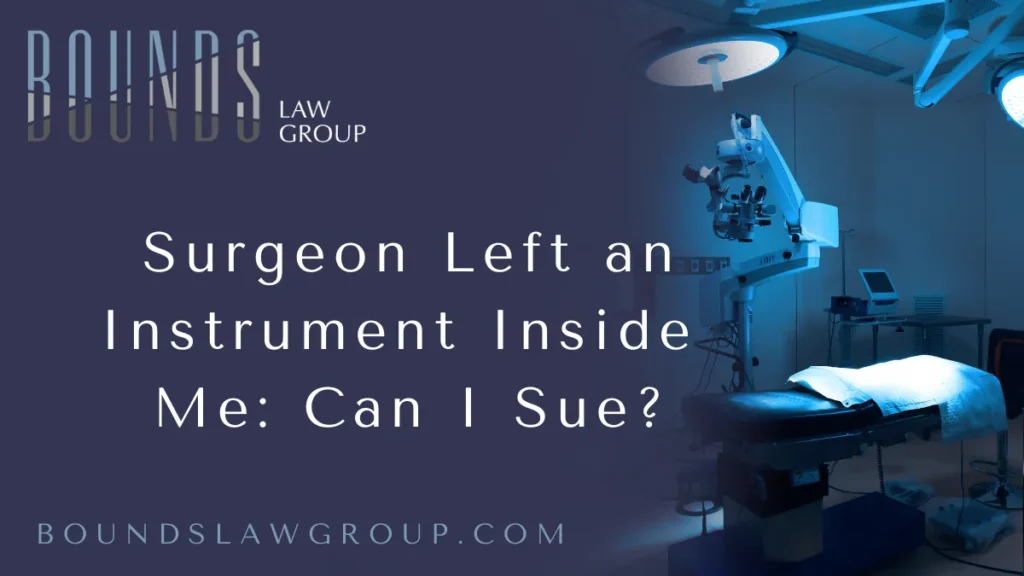
Retained Surgical Instruments | Bounds Law Group
What Are Retained Surgical Instruments?
Retained surgical instruments (RSIs) refers to any tools, sponges, clamps, gauze, or other foreign objects inadvertently left inside a patient after a surgical procedure. These objects are often discovered only after the patient experiences unexplained symptoms or complications.
Common examples of retained instruments include:
- Surgical sponges (gossypiboma)
- Hemostats and forceps
- Scalpels and scissors
- Needles and retractors
- Tubing and catheters
The presence of such items can cause severe internal damage. This often results in additional surgeries, long-term pain, infections, and even death.
Call us now at 877-644-5122 or complete the free case evaluation form to begin the process before it’s too late.
Is It Medical Malpractice to Leave a Surgical Instrument Inside a Patient?
Yes. Leaving a foreign object inside a patient is considered a "never event"—a term used by medical professionals to describe an error that should never occur under proper medical care. As such, this form of negligence often forms the basis of a retained surgical instruments lawsuit.
Under medical malpractice law, you must demonstrate that:
- A doctor-patient relationship existed.
- The surgeon breached the standard of care.
- The breach directly caused injury or damages.
Bounds Law Group has a strong record of proving liability in medical malpractice cases. Our legal team collaborates with medical experts to establish how the standard of care was violated and why the hospital or surgical team should be held accountable.

Symptoms of Retained Surgical Instruments
If you've had surgery and are experiencing unusual symptoms, it could indicate that a surgical instrument was left behind. Look out for:
- Persistent pain or swelling
- Unexplained fever
- Infection or abscess formation
- Digestive problems or nausea
- Sudden weight loss
- Palpable lump or hard area under the skin
Often, these symptoms prompt imaging studies such as X-rays, CT scans, or MRIs, which ultimately reveal the retained item. If this is your experience, you may be eligible for a retained surgical instruments lawsuit.
Who Is Liable in a Retained Surgical Instruments Lawsuit?
Multiple parties can be held responsible for this type of medical error. These include:
- The surgeon, for failing to ensure all instruments were accounted for.
- Surgical nurses, who typically are tasked with tracking instruments.
- The hospital or surgical center, for systemic failures or inadequate protocols.
Each case is unique, but at Bounds Law Group, we meticulously investigate all avenues of liability to identify every party who may have contributed to your suffering.
How Much Is My Retained Surgical Instruments Lawsuit Worth?
Compensation in these lawsuits depends on the extent of your injuries and damages. Victims may be entitled to:
- Medical expenses (current and future)
- Pain and suffering
- Lost wages and loss of earning capacity
- Rehabilitation and therapy costs
- Emotional distress
- Punitive damages (in cases of gross negligence)
Our attorneys at Bounds Law Group are experienced in evaluating damages to ensure no element of loss is overlooked. We work relentlessly to ensure victims are not under-compensated.
Statute of Limitations for a Retained Surgical Instruments Lawsuit
Time is a critical factor in any medical malpractice case. In many states, victims have two to four years from the date of injury—or from when the injury was discovered—to file a lawsuit. Some jurisdictions apply the "discovery rule", which may extend the filing window if the retained instrument was found long after surgery.
Failing to act within this period could result in your case being dismissed. That's why it’s crucial to complete the free case evaluation form or call us now at 877-644-5122 to preserve your rights.
Why Choose Bounds Law Group for Your Retained Surgical Instruments Lawsuit?
We are a law firm built on trust, advocacy, and proven results. With decades of experience in medical malpractice and surgical error litigation, Bounds Law Group stands as a powerful ally for patients and their families.
Here’s what sets us apart:
- Extensive medical malpractice experience
- Access to top medical experts
- Aggressive investigation and case preparation
- No fees unless we win your case
- Personalized legal care and communication
We take your injury seriously because we know how devastating surgical negligence can be. When a careless mistake changes your life, our mission is to make things right through maximum legal recovery.
Steps to Take If You Suspect a Retained Surgical Instrument
- Seek immediate medical attention. An accurate diagnosis is essential.
- Preserve all medical records. These are crucial for building your case.
- Do not speak to the hospital’s risk management or insurance team without an attorney.
- Contact Bounds Law Group for a confidential consultation.
- Complete the free case evaluation form or call 877-644-5122 to begin your path to justice.

How Are Retained Surgical Instruments Detected After Surgery?
In many retained surgical instruments lawsuit cases, the patient is unaware of the foreign object until symptoms develop—sometimes months or even years later. Detecting these items early is essential to preventing further medical complications. Fortunately, advancements in medical imaging and technology now play a key role in diagnosis.
Imaging Tests Used to Identify Retained Instruments
Medical professionals often rely on the following diagnostic tools to detect retained surgical items:
- X-rays – Metal instruments such as clamps or needles often show up clearly on standard X-ray images. However, sponges and gauze may not be as easily visible unless they contain a radiopaque marker (a material visible on X-rays).
- CT Scans (Computed Tomography) – CT scans are highly effective at identifying both metallic and non-metallic foreign objects. They also reveal the extent of internal damage, such as inflammation, abscesses, or organ impairment.
- MRI (Magnetic Resonance Imaging) – Though less commonly used due to safety concerns with metallic items, MRIs can be effective for locating certain materials not detected on X-rays.
- Ultrasound – This is particularly useful for identifying soft-tissue abnormalities or retained objects like surgical sponges, especially in the abdominal cavity.
Why Detection Often Fails Initially
Despite standard surgical protocols that include instrument counts before, during, and after procedures, human error can cause items to be overlooked. Contributing factors include:
- Emergency surgery conditions, where time constraints lead to protocol lapses.
- Multiple surgical teams, increasing the risk of miscommunication.
- Obesity or deep incisions, making visual confirmation more difficult.
- Inaccurate instrument counts, especially with small or numerous items.
At Bounds Law Group, we delve deeply into how the retained item went unnoticed and how standard hospital procedures failed to protect the patient. This information strengthens your retained surgical instruments lawsuit and helps establish clear liability.
If you or a loved one has undergone diagnostic testing that revealed a retained object, it is critical to act immediately. Complete the free case evaluation form or call us now at 877-644-5122 to discuss your case confidentially with our medical malpractice attorneys.
Sources:
- Johns Hopkins Medicine – Patient Safety and Quality
Discusses preventable surgical errors and their impacts on patient outcomes.
https://www.hopkinsmedicine.org - National Institutes of Health (NIH) – Retained Surgical Items
A comprehensive review of retained surgical instruments, risk factors, and prevention strategies.
https://www.ncbi.nlm.nih.gov - Agency for Healthcare Research and Quality (AHRQ) – Never Events
Explains the classification and reporting of surgical errors, including RSIs.
https://psnet.ahrq.gov

